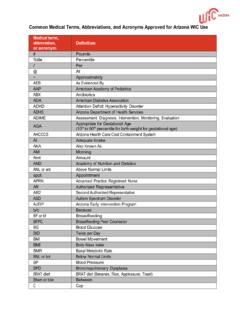Transcription of Identification Guide to the Common Mosquito Species in ...
1 Identification Guide to the Common Mosquito Species in ArizonaCompiled by Frank RambergMarch 2017 Whole Body (habitus) AedesaegyptiFemaleThe insect body is divided into three basic sections:1. head includes eyes, proboscis, palps & antennae2. thorax three pairs of legs & two wings attached3. abdomen4. legswingsmosquito or not?A Mosquito always has a long, slender proboscis. Other flies, like the crane fly at left may have an elongated face, but it will not be as long or slender as the Mosquito proboscis. On crane flies or midges, the mouthparts are at the tip of the snout. The proboscis of the Mosquito consists of an outer sheath, as above, with the slender threadlike piercing mouthparts inside , AedesaegyptiCulexerraticus stylets free of sheathelongated snout on crane fly headCrane flyMale or Female Mosquito ?The antennae of the male are feather-like, with long bristles or hairsThe palps of the male are almost as long as the antennae of the female are more thread-like, with short bristles or palps of the female aedineand culicinemosquitoes are much shorter than the proboscis(Aedesaegypti)4 Male genitaliaPalps on female Anophelesand AedesAnopheles hermsifemale proboscis palps Aedesaegyptifemale proboscis palpsAedesidentification charactersThe Aedesfemale has a narrowly pointed or tipped abdomen.
2 (This is also true of Psorophora.)The Culexfemale s abdomen tip is more broadly have aegypti(Linnaeus)Aedes aegypti, the yellow fever Mosquito , is now Common in southeastern Arizona. It is closely associated with and feeds primarily on humans. It is a small container breeder and will be collected around and in homes. It is active primarily during dusk and dawn. It is often noticed flying about ankles looking for an opportunity to feed. It is not usually thought to come very readily to CO2 traps, and newer sentinel traps are better for collecting aegypti is the main vector for dengue virus, Chikungunya virus, and Zika virus, which are potentially capable of transmission in southeastern are images that illustrate the adult characters for the Species . Also, Aedes albopictus, a related, similar Species that vectors both viruses but hasn t become established in Arizona, is (Aedes aegypti)Aedesaegyptifemalelyre-shaped scutalpattern8lyreAedes albopictusSkuseAedes albopictus, the Asian tiger Mosquito , is an introduced Species in the USA.
3 It is closely related to and closely resembles Aedes aegypti. It is an aggressive human biter, and it is also a vector of dengue virus and Chikungunya virus, both of which could be transmitted in Arizona. Ae. albopictus is not established in Arizona, but it has been introduced at least two times on plants ordered online from out of state. In Tucson the mosquitoes didn t become airborne. This specimen is a male reared from that sample. The eggs can come attached to roots and stems. As with aegypti, the eggs are laid just above the water on wet surfaces, and they dry out as the water does. They hatch when rewetted. Both Species are container breeders, and both are closely associated with two Species are quite similar, and the next slide shows the easiest character for distinguishing the (Aedes aegypti& Aedes albopictus)The scutum of Aedes albopictushas only one line of scales running back along the scutum, with white scale spots along the sides, just visible at the edges of the scutum of Aedes aegyptihas a lyre-shaped pattern, with two lines down the center of the abdominal sternitesof Aedesalbopictushave white basal scale bands, but the rest of the segment is dark scaled.
4 (Aedesaegypti& Aedesalbopictus)The abdominal sternitesof Aedesaegyptiare solidly aegypti & Aedes albopictusThis slide and the next slide show characters of these two Species that often survive heavy damage or rubbing that occurs in crowded trap samples:Aedes aegypti The clypeus of the female has two white scale spots. antennal basesclypeus with scale spotspalp tipsAedes albopictus no scales on the clypeus (antennae are missing on specimen)antennal basesclypeus no scalespalp tipsand, on the next aegypti & Aedes albopictusThe midfemur of the adult Aedes aegyptihas a dorsal strip of white scale spots. For this character, be careful to get the leg oriented to view the dorsal of Aedes albopictus femaleforelegThe midfemur of Aedes albopictus lacks the dorsal line of scale further detail, see Savage, H. M. & G. C. Smith. 1994. Identification of damaged adult female specimens of Aedes albopictus and Aedes aegyptiin the new world.
5 Journal ofthe American Mosquito Control Association10 (3): vexans(Meigen)Aedesvexansis a Common cosmopolitan Species that is most often found in rural habitats and wetlands along with Common wetland Species . It is an aggressive human biter, but it is not usually associated with disease the narrowed abdominal tip and the narrow white scale bands on the legs. The proboscis is unbanded, and the palp tips are dark, unbandedlegs unbanded15(Culex quinquefasciatus)scutum(dorsal area) of thorax mostly brown, no obvious color patternno pre-or postspiracularsetae16(Culex quinquefasciatus)abdominal tergites with light scaled, slightly convex basal bands17 Culex tarsalisCoquillett, 1904 Culextarsalisis one of the most Common Species in wetland and similar riparian habitats. As with quinquefasciatus, it feeds on birds, mammals, and humans. It is active at night, primarily. It also is a vector of WNV and StL. white-banded proboscis and leg bands that span tarsal segment breaks, as seen on this image, are good id characters.
6 Note, though that there are three Culexspecies that resemble tarsalis(stigmatosoma, thriambus, coronator), See following slides for 18(Culex tarsalis)The proboscis of Culextarsalis has a conspicuous white scale band that completely circles the proboscis. The palps are of the other tarsalis lookalikes, thriambusand coronator, do not have complete proboscis stigmatosomadoes have a complete ring, but it lacks the leg and body spotting noted in the next three Species may be encountered, but they aren t included here because they re harder to identify, especially in damaged specimens from CO2 & Ward includes good drawings of the abdominal sternite scale patterns that are the best be sure of tarsalis the top character on the next slide is most (Culex tarsalis) The legs of Culex tarsalis have lines of white scale spots that sometimes coalesce into white scale lines. The lookalike Species lack these spotsThis hind leg of tarsalisshows the white scale bands that span the tarsal segment breaks as seen in this closeup.
7 The three lookalikes also have this character, but the tarsal rings are not usually as base white scale tufts on Culextarsalis If a specimen of Culextarsalisis very badly rubbed or damaged, the white scale tufts on the antennal bases will often survive. antennal base tuftspalpsproboscisCulex erythrothorax DyarCulex erythrothorax is, like Culex tarsalis, a wetland or riparian Species . In Pima County, it has been collected at Sweetwater Wetland. It has a red to rust colored look overall. There are no light leg scale abdominal tergites are darkly scaled with narrow basal light scale bands or no basal bands at abdominal sternites are light yellow in inornata(Williston)Culisetainornatais similar to Culexquinquefasciatus, but it is larger and has prespiracularsetae and a setalpatch under the front edge of the wing near its base (next two slides). The legs are basically dark-scaled and unbandedCulisetainornatais found in a variety of waters, especially in wetland or riparian habitats.
8 It is a late or early cool season Species . This seasonal activity pattern seems to exclude it as a probable disease vector . The Species has a wide distribution in North following slides illustrate the characters noted above23 Culiseta inornata prespiracular setaeThe mesothoracic spiracle is a good general thoracic landmark. The drawing shows its location and the prespiracular setae of are no postspiracular setaeThe photo shows the spiracle overlaid by the prespiracular inornata subcostal setal patchThe top photo shows the setae patch on the underside of the front edge of the arrow to the bottom photo shows the location of the patch on the columbiae (Dyar & Knab) (= toltecum)& Psorophora signipennis(Coquillett)Psorophorais one of the major genera of floodwater mosquitoes. In Pima County, large emergences of adults accompany the summer monsoon season, especially in late July and August.
9 The top Species is Psorophora columbiae, and the bottom Species is the similar are similar to Aedes(Ochlerotatus) Species , but they have both prespiracular setae ( similar to those of Culiseta) and postspiracular setae (similar to those of Aedesor Ochlerotatus). Note the mixture of light and dark scales that give a salt & pepper appearance to them. The leg banding and abdominal markings will be very sharp on fresh specimens. Note, also, the relatively sharply pointed abdominal tip of these females. Overall size varies considerably, but signipennistends to be smaller than are very Common floodwater Species , and they are often found together. The following slides show wing and abdominal columbiae in the Southwest has recently been proposed to be a separate Species from Ps. columbiae in eastern North America, and the name toltecumhas been resurrected for it, thus making it Psorophora toltecum (Dyar & Knab).above photo Psorophora columbiaelower photo Psorophora signipennis26(Psorophoracolumbiae)pre-an d postspiracularsetaeprespiracularsetaepos tspiracularsetaeAbdominal tergites of columbiae & signipennisThe tergites (dorsal segments) of the abdomen of columbiaehave forward-pointing white-scaled triangles.
10 These tend to rub most quickly in the center, as in this image, but the triangular shape is often still tergites of signipennisare covered with white scales with little or no patterning discernable. This abdomen is a bit scale patterns of columbiae & signipennisThe wings of these two Species have both dark and light scales, but the wing of toltecumis mostly dark-scaled. The rear scale fringe of the wing is also forward edge of the wing of signipennis has white-scaled areas, and the rear scale fringe has dark and white-scaled areas. Overall, there is more white scaling than on the wing of characters of Anopheles30 The scutellum of Anophelesis smoothly rounded; the scutellum of the other genera has three distinct bodies of most Anophelesspecies are not covered with scales as in the other genera. Also, the palps of the female Anophelesare nearly as long as the proboscisCulextarsalisAnopheles franciscanusAnopheles franciscanusMcCrackenAnopheles franciscanusis the most Common Anophelesspecies.











